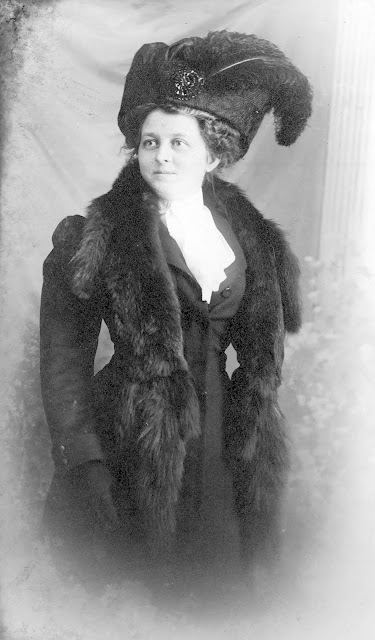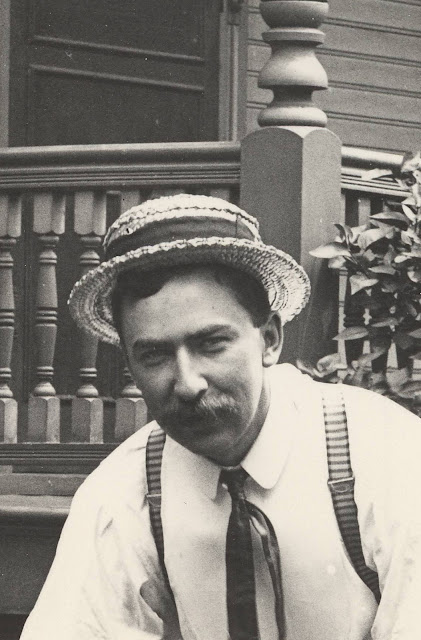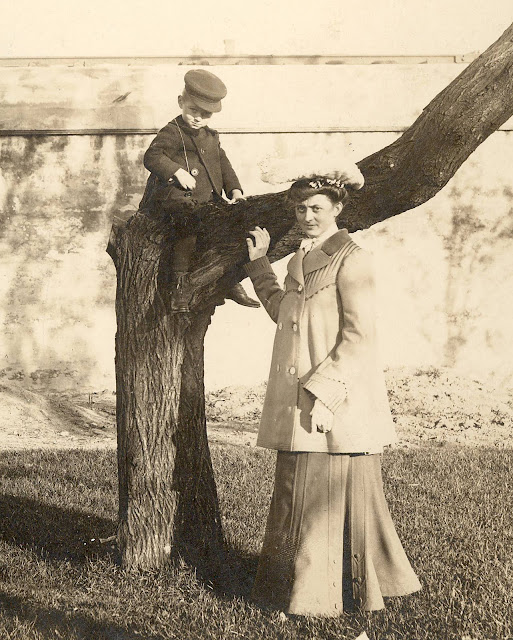www.scotclans.com, used with permission
As depicted above, our Scott clan motto is "Amo," which is "I love" in Latin. I have been impressed with the deep love our family has traditionally shown to each other in each generation and across generations. Here are some of the ways they have shown their love. [I have indicated the FamilySearch id #s for a few key individuals. You can find the rest by looking those up.]
Family reunions
We have photos of Scott family reunions, dating from the 1894 gathering of A. Graham Scott and his siblings, whose parents were Moses (FS#L211-YBH) and Mary Ann Graham Scott. I don't know how common it was for families to gather in reunions, but ours is likely unusual in the photographic record that we have!
The Scott family held many reunions over the years, as shown in the following photos, many of which are posted on FamilySearch, where the individuals are identified whenever possible.
 |
| 1906 Scott reunion. A. Graham Scott is 2nd from the right on the back row. See FamilySearch for identification of other family members in the photo. |
Here is a list of the reunions of the Moses Scott descendants (1894, 1906, 1907 and 1917), then Aaron Graham Scott (FS#L3F9-QGZ) descendants (he went by Graham), based on the records and photographs that we have. It's likely we will discover more reunions as we examine their letters more closely. A. Graham Scott evidently began the reunion tradition, which was carried on by his oldest son, Elzumer Scott (FS#K2QH-71F), after his father passed away in 1922.
Scott family reunions
1894 Missouri
1906 near Ridgeway, Missouri
1907 Missouri
1909 Ridgeway
1911 Ridgeway
1916 Ridgeway
1917 Marion, Missouri (see photo and newspaper clipping below)
1920 Meridian, Idaho
1932 Idaho
1933 Idaho
1939 Big Springs, Idaho
1946 Jackson Lake, Wyoming
1953 Hot Springs, Arkansas
 |
| 1939 Scott family reunion (descendants of A. Graham Scott) in Big Springs, Idaho |
Here is a delightful account of the 1939 reunion from a newspaper, with family memories written as a song to be sung to the tune of "Oh Susannah." Other reunions were also written up in newspapers, some based on articles that Elzumer Scott submitted.
Another way that the Scott family showed their love and kept in touch was through letters. When A. Graham Scott passed away in 1922, he had 16 living children. I'm going to list them here because this post is publicly searchable and I'd like for descendants to be able to find their ancestor among the children.
Children of A. Graham Scott (FS #L3F9-QGZ) and Aneliza Bandy Scott
Mable Scott (1872-1877)
Elzumer Scott (1874-1961) (aka "Zumer")
Charles Jarred Scott (1876-1951)
William Ota Scott (1878-1943) (aka "Ote")
Oscar Charles Scott (1880-1961) (aka "Nick")
Minnie Scott (1882-1964)
Zenith Wayne Scott (1887-1969)
Eva Scott (1889-1961, twin)
Edna Lee Scott (1889-1971, twin)
Ruth Scott (1891-1951)
Mary Lou Scott (1993-1977)
Benjamin Scott (1894-1895, twin)
Ralph R. Scott (1894-1972, twin)
Children of A. Graham Scott and Eva Alice Eyerly Scott
Howard Eyerly Scott (1899-1963)
Russell George Scott (1900-1954)
Raymond Graham Scott (1902-1963)
Fern Esther Scott (1904-unknown)
Ione Martha Scott (1905-1976)
Family members had always kept in touch through letters, but after Graham passed away, they created a Scott chain letter in 1922, and printed official letterhead stationery in 1929. It appears that Zene was the first to manage the chain, then Elzumer, then his son Kenneth, and finally Kenneth's younger brother, Roland. The Scott chain letter, in one form or another, continued for more than 65 years! Because Zene, Elzumer, Kenneth, and Roland kept or made copies of many key letters, we can read them today. We have 835 letters (and some documents) from A. Graham Scott and his children (not including Elzumer), 763 letters and docs from Elzumer, and 1783 letters and docs from Kenneth and Mary Scott (including some early letters from their sons).
In addition, Graham's descendants created a Scott Family Association in 1939. Elzumer's notes (below) record in part "Had our big bonfire outside 6:30 to 8 pm. & roasted weiners & marshmallows. After that was over we went inside Inn for singing and business session. At this meeting the following officers were elected for the ensuing year: E. Scott. Pres. Edna Smith V. Pres. and Z.W. Scott Secy-Treas. It was suggested our organization be named “Scott Family Association”.
Here's an example of a letter from Howard, another of Graham's sons, to the Scott chain that was retained by Zene in the "permanent" file. Be sure to read his humorous account of the trek west from Missouri to Idaho in the box car with Graham's and Elzumer's furniture!
As I recall, it was Howard's glowing descriptions of the west that motivated Graham to sell his prosperous farm in Missouri and move to Meridian, Idaho, at the age of 70 (two years before his death). Further evidence of the Scott siblings love for each other is that many of them moved west around the same time. (A side note: As a result of this major relocation, some descendants, including Kenneth, joined the Church of Jesus Christ of Latter-day Saints.)
We'll need to do more research to find out exactly which of Graham's children moved west with him, but by the time of the 1939 reunion, at least four his children and their families were living in Idaho, with others in Illinois, Indiana, Washington, D.C. (Kenneth and Zene), Colorado, and California.
The chain letter worked this way: a family member would receive a packet with everyone's letters, remove their old letter, put in a new letter, and send the packet to the next person/family on the chain. Here's an example of a routing list:
In addition to organizing reunions, writing letters to the family, and managing the family chain letter, Elzumer recorded family history information (as early as 1899) and he and Zene kept records when family members were born, married, and died. Here's an example of early records he kept (in about 1910). (Note: The first generation is not correct, but from Jacob Sallee forward is accurate.)
The Scotts were a picture-taking family, especially Elzumer and Kenneth! We have photos of the Bandy, Sallee, and Scott families (by far the majority of A. Graham and descendants), totaling 3,287 images (in some cases front and back, plus some duplicates). Elzumer appears to have been the family photographer, beginning with the first photo in this post, taken in 1894.
Here is Elzumer with his camera at the 1939 reunion. We have an entire photo album of that reunion, containing about 150 photos. Kenneth continued the tradition, taking many photos and movies of his family. We have 4,513 images (including fronts, backs, and duplicates) for Kenneth and Mary's family. Fortunately, Elzumer, Zene, and Kenneth were great about labeling photos on the back, so we can identify family members!
 |
| Elzumer Scott and camera, Scott family reunion 1939, Big Springs, Idaho |
 |
| Zene's note on the back of this photo says, "Kenneth, Roland (eating or singing), Harry" |
Scott family members had a great sense of humor and loved to laugh and sing together. They shared many funny stories in their letters to each other (like Howard's above) and made joking comments about each other's letters.
Our Scott ancestors (and collateral lines) fought in many of the great wars, including the War of 1812 (John Dunkerson, FS#L8MJ-ZKR, a hero in the pivotal Battle of Lake Erie), the Civil War (including Elzumer Scott, b. 1844, FS#KJCJ-L7B and Thomas E. Sallee FS#LHWP-YCS), and World War II. More research needs to be done on the military service of our family members. During WW II, family members noted relatives who were serving and circulated the "Honor Roll" in the Scott family chain letter.
The Scott, Sallee, Bandy and other ancestral families were devout Christians. That's worthy of another post, but for now, I'll share just one example, a letter from Thomas E. Sallee to his daughter Carrie Mae and her husband Elzumer Scott, the day their son Raymond died, barely more than a year old.
These are just a few examples of the love Scott family members had for each other and for the Lord. Preserving these letters, documents, and photos--and faith in Jesus Christ--has been a multi-generational effort.
I have posted many letters and photographs from our Scott ancestors at FamilySearch. You can sign up for a free account there and see what's available by searching for a relative in the Tree. We're constantly adding new material. FamilySearch is a lot like Ancestry except that everyone is working on one common Tree--the ultimate in crowd sourcing!
What will we do to continue this amazing legacy our Scott ancestors have given us? Will we pass on the stories of how our ancestors loved and supported each other in challenging and happy times? Will we leave a record to inspire our children and grandchildren?
Share your ideas and efforts in the Comments section below!


















































